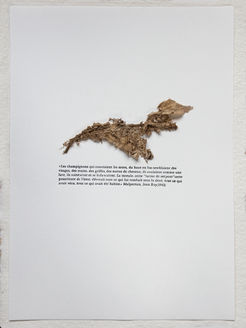PROJECTS
(2018-2023)
La Mérule Pleureuse
Traditional printing press on paper, 2023

The project revolves around studying the natural interplay and coexistence of organisms such as algae and fungi within a human-inhabited environment. The focus lies on examining a specific fungus ( La Mérule Pleureuse ) that thrives in the conditions found within human-constructed habitats. Merule, scientifically named Serpula Lacrymans, commonly known as dry rot, grows in the timbers and sometimes walls of buildings.It have successfully adapted to and thrive in human constructed environments, taking advantage of the resources and opportunities provided by humans. The term 'Pleureuse' translates as 'tearful' or 'cry,' as these fungi often have small droplets of water on their fruiting bodies. If the original water source is removed, they can survive by generating water through the breakdown of timber.




LA MÉRULE PLEUREUSE - Solo exhibition, La Chartreuse de Neuville, Neuville-sous-Montreuil
La Chartreuse de Neuville, a medieval monastery situated in Neuville-sous-Montreuil, France, has been severely damaged by Mérule. The building dates back to the 14th century and is constructed primarily of chalkstone and timber. Over time, the fungus was able to colonize the wooden elements as well as the stone walls of the building, causing significant damage to the structure. In some areas, the fungus has completely destroyed the wooden elements, leaving large gaps and holes in the building's framework. Currently, the building is undergoing an extensive restoration process, marking it as one of the largest historical monument project in France. The restoration aims to eradicate the mycelium traces for the third time in the building's history. The process involves the complete removal of fungi and its symbiotic partner algae from the building's interior, the extraction of infected wood, and the application of fungicides.
The series features printed text created using a traditional printing press on paper. The texts were selected from ancient manuscripts that delve into the historical accounts of fungal infections, early scientific publications that discuss mérule, specifically detailing the destructive impact of it on buildings and even human well-being, a passage extracted from the Bible, which serves as a warning about mérule and suggests rituals for purifying fungal infestations and writings that use Serpula Lacrymans as a metaphor to represent the decay and deterioration of both society and culture.
















